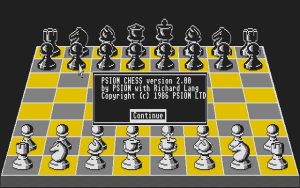Psion
Psion (Psion Chess),
a former commercial chess program developed by Richard Lang as successor of his first program Cyrus. In about 1983 Lang started to write his new program for 68000 based processors in assembly language [2] , when he was about to abandon the work for Intelligent Software, who owned the Cyrus brand name. Psion was first marketed by Sinclair Research for Sinclair QL [3] and later under Psion's own label for 68000 based Apple Macintosh and Atari ST homecomputers, in late 1983 ported to 8086 based PCs running under the MS-DOS operating system.
Psion was the shared winner of the WMCCC 1984, and also won the Software Event of the WMCCC 1987. Richard Lang's early Mephisto programs, such as the WMCCC 1985 winner Mephisto Amsterdam, were based on Psion [4] .
Quotes
Quote by Kaare Danielsen from his WMCCC 1987 report [5]
Clearly, Richard Lang has produced the strongest microcomputer program in the world. It searches 4-5 plies brute force plus up to 6-7 plies selective search. The program contains a lot of chess knowledge, which is used both in the tree and to create piece-value-tables. The chess knowledge was obtained from chess masters, who analyzed games played by the program. The program has an asymmetric evaluation function, which emphasis safety (has rules like 'do not start a wild attack, but worry a lot if the opponent does so'). The program searches about 4000 nodes per second on a 28 MHz 68020, but this includes a thorough analysis at every node, including a swap-off evaluation (static analysis of captures instead of a capture search).
Namesakes
According to Chris Whittington the chess software for the Psion 3a PDA was written by Ren Wu [6] . A further Psion Chess program for Psion Series 3 and Psion Siena PDAs was written by Johan Van Barel in C [7] [8] .
Publications
- Tony Harrington (1984). Checkmate. Personal Computer News, November 1984, pdf
- John Krause (1986). Psion Chess for IBM and Macintosh. Compute!, Issue 69, pdf
- Christopher Chabris (1987). Reviews: The Game of Kings - START's First Chess Tournament. STart Vol. 2, No. 2
External Links
- Psion's ICGA Tournaments
- Youtube video : Psion 2.00 on the Atari Stacy 2
- Sinclair QL Computer Wiki - Psion Chess
- Psion Chess from MobyGames
- Psion Chess from Wikipedia.de (German)
- Psion from Schachcomputer.info Wiki (German)
References
- ↑ Psion Chess screenshots from MobyGames
- ↑ Richard Lang - Question & Answer Interview given to a German magazine in 2003, pdf hosted by Mike Watters, Chess Computer UK
- ↑ Sinclair QL Computer Wiki - Psion Chess
- ↑ Psion from Schachcomputer.info Wiki (German)
- ↑ Kaare Danielsen (1987). The 7th World Microcomputer Chess Championship, Rome, Italy, September 14-20, 1987. ICCA Journal, Vol. 10, No. 3
- ↑ Re: Chess software for psion post 5 by Chris Whittington, rgcc, April 18, 1996
- ↑ free Chess for Psion 3 palmtop by Johan Van Barel, rgcc, January 14, 1997
- ↑ Psion Chess by Johan Van Barel
